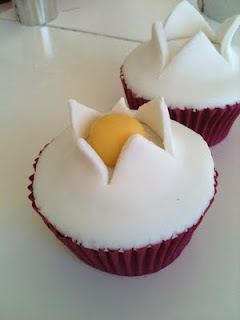So the least I could do was to celebrate the event with a horse race cake.
In Australia, it's 'the race that stops the nation' - so of course the other side of the flag had to read...
As Flemington race course has a grass racing surface (Mr Cupcake helpfully informed me of that, I assumed they raced on a sandy track) I made a little grassy ring on top of a sandy track-type surface.
If I'd had an oval tin, I would have used that, but mehhh.... circles are good for racing too aren't they?
This was the very simple start to the horse race cake. A chocolate mud cake, adapted to be gluten free (regular readers of this blog will begin to notice a pattern here) - I swear, it makes not a jot of difference to the taste.
I had two cake tins exactly the same size and 'nested' them to bake this, so that there would be an extra layer of insulation - the tins were quite thin so this effectively doubles the thickness of the tin and ensures a more consistent heat spread and a better result.
I drizzled the cake with a diluted, strained apricot jam to keep it moist, then ganached the cooled cake and hot-knifed the ganache for a smooth surface (detailed instructions here).
Then I rolled out a piece of sandy-coloured fondant big enough to cover the top and sides in one piece, and draped it over, attaching it to the cake with a light painting of water.
I smoothed the fondant from the centre outwards, using first my hands, then a cake smoother (amazing plastic contraption that looks a bit like a skinny little iron). I trimmed around the base really carefully - this is actually really hard to do, and usually I have to cover my terrible mess with a ribbon on the base. But I was really OCD about it this time, and it paid off.
So then it was time to work on the horses.
I'd seen a blurry front-on pic of a horse figure that some brilliant person had posted on Facebook's Cake Decorating Society page. That started me on my modelling but there was a lot of experimentation involved.
Here you see the horse body (the big bit), and the four little legs, with toothpicks sticking out for support when the figure is put together.
Same deal, different colour - once I had a pattern I tried to be consistent in size and shape, and kept a finished horse beside me all the time to use as a model.
This disembodied horse's head may freak out anyone who's seen The Godfather, but I promise you it's perfectly innocent. His little head had to be made separately before being attached because of the detail on the face.
Ears were two layers of teardrop shaped fondant in contrasting colours; his blaze (do you call it that? - Yasmin, my most knowledgeable horse friend where are you when I need you) - anyway, his STRIPE down his nose, and his muzzle, were rolled fondant cut into a strip and pressed by hand into an oval, respectively.
The two nostrils were made with tweezers - I keep a pair exclusively to use for cake decorating.
I was worried about whether his little legs would collapse under the weight of his big fat tummy, but fortunately he held together very well, the little darling. He looks a bit scared. Big race coming up.
He looked even more worried when I added his mane and tail.
So I gave him some friends as quickly as possible, to calm his nerves and get some track work underway.
Cornflour helps their little hooves from sticking to the track.
This is a rather undignified shot of a cheeky little mare with a white mane and tail.
Her hairy bits were created from little strips shown here - the top one is the mane, and the lower is the tail, which gets rolled up a bit at one end and attaches to a little hole in her backside with a drop of water.
Track work now commenced in earnest with four gallopers trying to lose their paunches before the big race.
The one at the back still looks absolutely terrified, poor darling.
...And so it was finally time to get them onto the course. As Mr Cupcake pointed out, their jockeys have not yet mounted, so this is possibly a training run.
Place your bets, ladies and gentlemen... have a wonderful Melbourne Cup Day and think of me and my colleagues in the office, taking a break for the few minutes of the race and accompanying it with a little bit of horse race cake!





















































